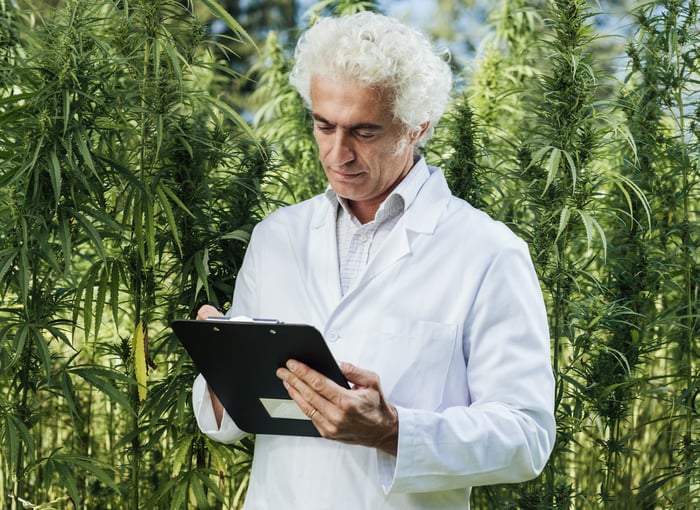The biggest day in the history of the marijuana industry has come and gone. A little more than three weeks ago, on Oct. 17, Canada became the first industrialized country in the world to give the green light to adult-use cannabis. With recreational marijuana prohibition now a thing of the past and the industry on pace to thrive, Wall Street and investors are looking for perhaps $5 billion or more in added annual sales.
But what a lot of investors are likely overlooking is that despite a lot of domestic and international demand -- international demand is strictly for medical cannabis -- this is an industry that's going to take a lot of time to mature. In particular, it's probably going to be years before we see marijuana growers reach their touted peak production capacity.

Image source: Getty Images.
Canada's regulatory environment is partly to blame
As much as we'd like to think that growers are churning out production at a breakneck pace, it doesn't work like that in the real world. In Canada, growers need to first gain a cultivation license from Health Canada, clearing them for planting and harvesting. Canopy Growth Corp. (CGC -0.57%), which is aiming for 5.6 million square feet of peak production capacity, only has 2.7 million square feet approved for cultivation at the moment.
The issue, as highlighted by Marijuana Business Daily back in May, is that Health Canada is overwhelmed with more than 500 cultivation license applications. These applications take anywhere from a few months to perhaps years to approve, which could sideline production that might otherwise quickly find a buyer.
Then, once marijuana growers have landed their cultivation license, they'll need to apply for a sales permit. That's right: Just because Health Canada says you can grow it doesn't mean you're allowed to sell it. These sales permits were taking an average of 341 days to gain approval back in May, with the fastest noted approval at the time taking approximately four months.
These regulations are very much needed in order for Health Canada to maintain control over the seed-to-sale process. Unfortunately, it means an extended delay in getting product to market when demand is (pardon the pun) high.

Image source: Getty Images.
It'll take years for growers to ramp up production
Beyond just regulatory concerns, it's going to take quite some time before marijuana stocks are producing at a rate that'll be sufficient to satisfy the domestic market. Below are the rough estimates -- some company estimates, others author-estimated -- for peak production from Canada's largest projected growers.
- Aurora Cannabis (ACB -3.74%): 600,000-plus kilograms
- Canopy Growth Corp.: 500,000 kilograms
- Aphria (APHA): 255,000 kilograms
- Tilray (TLRY): Around 200,000 kilograms
- The Green Organic Dutchman (TGOD.F 15.38%): 195,000 kilograms
Clearly, there's some interpretation in these figures. Whereas Aphria and The Green Organic Dutchman have specifically stated their belief that they'll produce 255,000 and 195,000 kilograms, respectively, Canopy Growth and Tilray haven't offered any production guidance. With Tilray's prospectus calling for a little over 850,000 square feet of capacity to be completed by the end of this calendar year, perhaps generating 75,000 kilograms in annual run-rate production, I'm making an educated guess that it'll use its nearly 3 million square feet of available land to expand capacity.
Assuming these production figures are accurate, the top-five producers could yield around 1.75 million kilograms per year in aggregate. When the entire industry is running on all cylinders, these five marijuana growers could be generating more than half of all production.

Image source: Getty Images.
But here's a rough look at where these top-five pot stocks are producing right now, either based on their own run-rate figures or an extrapolation of their most recent production results.
- Aurora Cannabis: 45,000 kilograms, as of September 2018
- Canopy Growth: 40,0000 kilograms on an extrapolated quarterly basis
- Aphria: 35,000 kilograms, according to the company
- Tilray: 6,000 kilograms on an extrapolated quarterly basis
- The Green Organic Dutchman: zilch!
Currently, the top-five growers are only yielding 126,000 kilograms at an annual run rate. They aren't even a tenth of the way to their collective peak production capacity. And, as you'll note, The Green Organic Dutchman isn't even expecting its first sale until the first half of 2019, and the leading producer, Aurora Cannabis, hasn't even hit six digits yet.
We're likely looking at many years before these growers are anywhere near their pie-in-the-sky production figures, and that's going to mean a downward adjustment in the sale and profit potential for all five of these marijuana stocks. As much as we'd like to believe these stocks will go from zero to 60 mph overnight, that's very unlikely, and it's something that marijuana stock investors should keep in mind.





